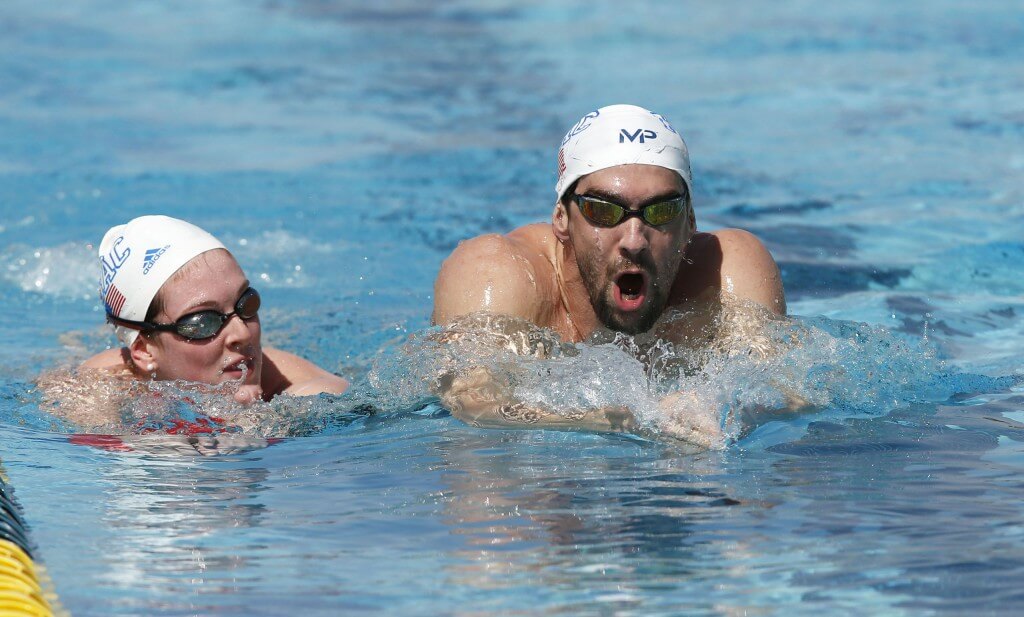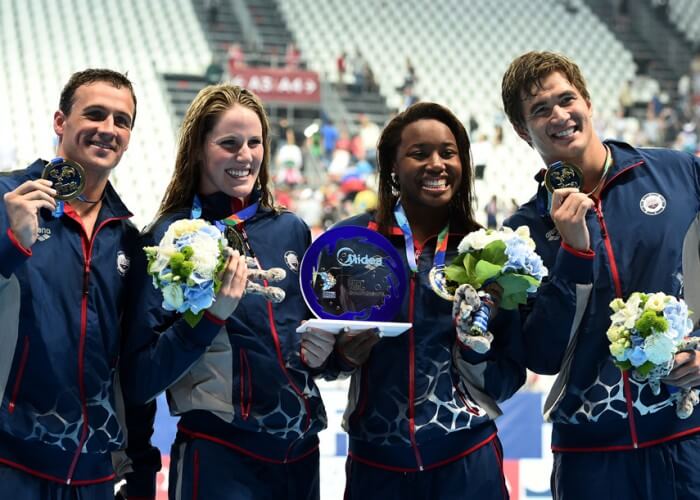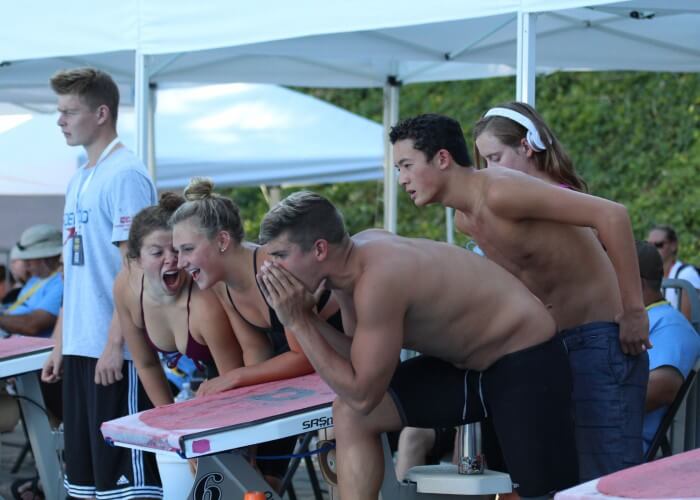Rewriting the Social Script: Swimming’s Role in Gender Friendship

By Connor Bailey, Swimming World College Intern
There are men’s and women’s teams for soccer, volleyball, water polo etc. Really, almost every sports is divided by gender, and when there are companion teams–say for a single school–they don’t really interact with each other. But, swimming is different.
Though in name there are men’s and women’s swim teams, most have no real distinction. And though they may swim in different heats, girls and boys will practice together and have meets together. When I think about “my team” I don’t just think about the men I think about the men’s team and the women’s team together. And I don’t think I’m alone in that. The 2012 US Olympic Swimming Team’s famous “Call Me Maybe” video did not have just the men, or just the women, but everyone on that team. While most sports serve to isolate athletes from those of the opposite gender, swimming can be a place where children have a greater opportunity to create friendships that span gendered social barriers.
I became aware of this part of swimming when I realized that I was a bit of a social oddity; most of my friendships have been have been cross-gender friendships. In high school, at the height of my gender-imbalanced social life, my core friend group consisted of me, one other guy, and about a dozen girls. Almost all of those friends I had as a direct result of my involvement in swimming.
If it were not for swimming it is doubtful that I would have had as many girl friends and I would not have the benefits of all those friendships. But I don’t think I’ve ever heard anyone say they liked swimming because it allowed them to be friends with swimmers of a different gender. Frankly, I think it’s time that we realize this as a real benefit of swimming and celebrate it as such.
Generally, cross-gender friendships are becoming more and more common; it’s a trend that mirrors the society wide breakdown of gendered spaces (like more women entering the workplace).[1], [2] And that’s good because there are a number of benefits that come from cross-gender friendships.
There are straightforward reasons, like: doubling ones number of potential friends, buoying confidence in ones attractiveness to those of another gender, and gaining an otherwise unobtainable perspective on the opposite gender. But there are also more complicated benefits like encouraging communication across genders in order to reduce sexual harassment and sexism, as well as breaking down the male-dominated social networks that empower men while exclude women from access to resources and positions of power.[1], [3], [4]
Perhaps most complicated, but most importantly, heterosocial friendships actually serve to redefine friendships for those involved. That’s because in same-gendered setting men and women relate to each other differently, and when they come together they bring those social patterns to their mixed-gender friendships.
One sociologist, Harry Brod, once referred to men as generally having “side-by-side” friendships centered around peripheral interaction and shared activity, while women’s friendships are more often “face-to-face” with a greater emphasis on direct dialogue and emotional care. Cross-gender friendships usually end up somewhere in-between, which is why men often report that they value their female friends for their engagement, while women often report they enjoy their male friends because they see the relationship as relaxed.[1], [2], [5]
But, despite these benefits, cross-gender relationships are still regarded with suspicion. In a reflection of that social suspicion, since cross-gender friendships were first studied in the early ’80s, sexual tension has been a major focus of the psychological and sociological research, and that focus hasn’t dissipated. [1], [3], [6], [7]
In truth, people report some level of sexual tension in most of their heterosocial friendship. However, you would be wrong to conclude, like so many others, that “men and women can’t be just friends.” The research shows even though many men and women report sexual tension, most relationships never become romantic or sexual. And, most of the platonic (non-sexual) friendships that “cross-over” quickly return to their original platonic dynamic.
The general conclusion of the research is that the main reason for the “problems” with cross-gender friendships—both the internal and external projections of sexual tension—is that people don’t having alternative models for these friendships. There are “social scripts” for these relationships, and those scripts don’t include men and women being friends—even though it is a reality for many, many people.[1], [3], [4]
Our shared stories (TV, movies, music, books), often conflict with the realities of lived experience. Those stories exalt romantic and sexual relationships while downplaying friendship relationships. And, generally speaking, cross-gender friendships either don’t exist or are undermined by when they inevitably become romantic. But that’s a problem with the social environment, not with people.
And therein is the central issue. That script needs rewriting. And swimming can help to update that outdated–and ultimately disruptive–social script.
Swimmers and their teammates are often nearly naked together. But, we quickly get used to it. Any initial awkwardness or hints of sexuality have a tendency to disappear. Similarly, swim teams can normalize cross-gender friendships, and neutralize the disruptive social baggage (like awkwardness and sexuality) of the friendship. Meaning that if swimming provides an environment where young boys and girls can be close friends, they should also be able to continue to make those kinds of cross-gender friendships later in life because their scripts and models for what is a friendship have been updated.
Now, this heterosocial aspect of swimming has been very important in my life. Like I said, I’ve always had more girl friends than guy friends, but it’s because of swimming that I’ve had some of my best and most formative cross-gender friendships. So, in light of the impact it’s had on my life and the benefits I see in it, I am very surprised that I hear so little about this part of swimming. In fact, I have never heard anyone say explicitly that swimming is good because it provides an environment for boys and girls to be friends.
The good news: I don’t think we need to change much. Swimming has already played a role in breaking down gendered social barriers, my only concern is that it continues to do so. For that to happen it’s important that those in the swimming community be aware of the heterosocial nature of the sport, and actively celebrate the beneficial outcomes of this part of swimming.
Future swimmers should not need to write or read anything like this. Instead, by the time they finish swimming they know it and understand how they are better off for growing up in a swimming community. Looking forward, we need to make sure that awareness begets action and that those with power to shape the teams’ social environment—that means mostly parents and coaches—evaluate team policies or activities and make sure they don’t undo one of swimming’s best hidden benefits.






<3 this
You are 100% right but may I also add the cross age friendship! Swimming connects gender and age !
This is great, thanks. And master’s swimming even better as it promotes cross-age friendships across the decades. Swimming is finally slowly growing in ethnic/racial/socioeconomic diversity too, which will is another awesome development.
I like this! Julie Christiane Brad Kozell
I thought it was going to be the girl who is swimming as a guy in college.
That’s because you’re confusing cross-gender with transgender.
Sarah Steinke, Renna Pispidikis, Kaitlin Thatcher, glad we met in swimming 🙂
While the deal was initially for a “one-week dialogue polish”, Gottlieb eventually became the primary screenwriter, rewriting the entire script during a nine-week period of principal photography. The script for each scene was typically finished the night before it was shot, after Gottlieb had dinner with Spielberg and members of the cast and crew to decide what would go into the film.